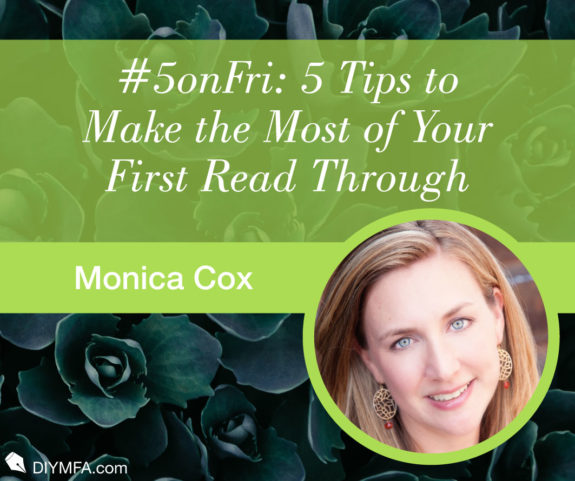There is nothing like the feeling of typing “The End” on your rough draft. Writing a novel is a huge accomplishment and you should celebrate! Have a treat, share a toast with friends, reward yourself with a new book from your favorite independent bookstore, or have an impromptu living room dance party. Whatever you do, be sure to honor and enjoy this moment.
Because after the celebration, the real work begins.
Before you can start the hard work of revising that rough draft into a first, second, third, or final draft, there is a very important step you should not skip: the read through.
Rough drafts are often how writers tell ourselves the story. There is so much discovery as we write. Entire subplots may surface or be abandoned as you follow a new, more inspired thread. Characters may have suddenly appeared or disappeared. Timelines can be nebulous or nonexistent. The first read through is your opportunity to see what you actually wrote, not what you set out to write or what you think you wrote.
Reading your full manuscript in its entirety for the first time can be a challenging task. If you’re anything like me, you might find yourself pulled into the weeds of your words and scratching suggested line edits in the margin as you read. Resist this temptation! This first read through is the time for a big picture assessment of what actually exists on the page so that you can identify troublesome, deal-breaking, big, structural story problems first. Save the line edits for last.
As you prepare for your first read through, here are five tips to set your revision up for success:
1. Step Away
Take some time away from your manuscript to gain perspective on it. Wait several weeks, if you can, before reading. Don’t rush straight into editing the beginning the minute you reach “The End.”
You want to view your manuscript with fresh eyes. Also, if you can, read your pages in a different place and on a different device than where you wrote them. Put the document on your e-reader or print it out in a different font than you drafted. Cuddle up on a sofa or a hammock to read, anywhere but the desk, dining room table, or coffee shop where you wrote it.
The goal is to read your manuscript like a brand-new book. Because it is!
2. Take notes
Keep a notepad next to you and jot down the big-picture questions that arise as you read.
It’s important to do this somewhere other than inside the document. Resist the urge to note things like “move paragraph 2 to page 14.” Instead, note when you have questions about the plot, are bored or started scanning, when a character does something that doesn’t make sense, or when subplots get dropped or inserted abruptly.
3. Character Change
On a separate page in your notepad, write down what your character is feeling at the start and end of each chapter.
Much like your overall story arc must demonstrate a change in your protagonist, each scene and chapter must also include a small change. Did your protagonist go from angry to guilty? Hopeful to rejected? Meek to confident? Each micro-change will create a staircase for your character’s ultimate transformation.
Go ahead and make a note of what, if anything, is changing in your character in each scene or chapter so you can find the spots that need shoring up later.
4. Story Trajectory
In between each chapter, jot down which of the following phrases connects one chapter to the next:
- Because of that
- But
- Therefore
- And then
If you notice a lot of “and then” connections, you will need to look at whether your protagonist is making decisions or simply reacting to the world around them. You want your main character to have agency, to make choices that result in consequences (because of that/therefore) or new obstacles to overcome (but).
If your story is simply a series of events happening to a character (and then), it will lose its narrative drive and won’t hold the reader’s interest.
5. Review your notes
Once you’ve finished reading, review your notes and look for patterns.
Write a list of the big story problems. Issues to look out for include: character motivation, stakes, arc of change, consistent point-of-view, and whether you are fulfilling the promise of the premise (i.e., is the book telling the story you set-up on page one?).
Check your notes for places where you asked yourself, “why did she do that?” Add a character motivation category and list all the places you noted it was missing. What do those scenes have in common, if anything? Make a subplot category and list any problems you noticed, especially if it disappears for two hundred pages or no longer seems relevant to the main story thread. Make a trajectory category and note chapters with a weak connector phrase and use that information to revisit your outline.
Once you’ve read through and compiled your notes, you can make a revision plan. Start with the big issues first. Think of this revision plan like a renovation in your home—you don’t repaint a room when the foundation needs to be shorn up. Take a look at your foundation—the character’s motivation and their trajectory through the story—and make sure it is sturdy before you tackle the other items on the list like timeline, subplots, plot holes, etc….
Revisions can ultimately take several passes and require several additional read throughs. When that time comes, follow these steps again until you have a version that structurally stands up to your harshest revision eye. At that point, my writer friends, you can go in and line edit to your heart’s content!

Monica Cox is a writer and book coach living in North Carolina with her husband, two teenage boys, and a cranky but adorable cat. A former public and media relations executive, she now guides writers through their writing and revision process. Her goal is to give writers the encouragement, feedback, and tools they need to keep writing, finish their manuscripts, and strengthen their craft along the way. Connect with Monica at monicacox.net and on Instagram and Twitter.







